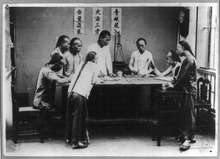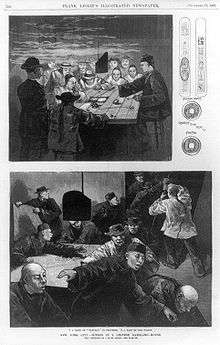Fan-Tan

Fan-Tan, or fantan (simplified Chinese: 番摊; traditional Chinese: 番攤; pinyin: fāntān, literally "repeated divisions") is a form of gambling game long played in China. It has similarities to roulette.
History

Fan-tan is no longer as popular as it once was, having been replaced by modern casino games, and other traditional Chinese games such as Mah Jong and Pai Gow. However, it was once a favorite pastime of the Chinese in America. Jacob Riis, in his famous book about the underbelly of New York, How the Other Half Lives (1890), wrote of entering a Chinatown fan-tan parlor: "At the first foot-fall of leather soles on the steps the hum of talk ceases, and the group of celestials, crouching over their game of fan tan, stop playing and watch the comer with ugly looks. Fan tan is their ruling passion."
The large Chinatown in San Francisco was also home to dozens of fan-tan houses in the 19th century. The city's former police commissioner Jesse B. Cook wrote that in 1889 Chinatown had 50 fan-tan games, and that "in the 50 fan tan gambling houses the tables numbered from one to 24, according to the size of the room."
Fan-tan is still played at some Macau casinos.
The game
A square is marked in the centre of an ordinary table, or a square piece of metal is laid on it, the sides being marked 1, 2, 3 and 4. The banker puts on the table a double handful of small buttons, beads, coins, dried beans, or similar articles, which he covers with a metal bowl, or "tan koi".
The players then bet on the numbers, setting their stakes on the side of the square which bears the number selected. Players can also bet on the corners, for example between No. 2 and No. 3. When all bets are placed, the bowl is removed and the "tan kun", or croupier, uses a small bamboo stick to remove the buttons from the heap, four at a time, until the final batch is reached. If it contains four buttons, the backer of No. 4 wins; if three, the backer of No. 3 wins; if two, the backer of No. 2 wins and if one the backer of No. 1 wins.
All winning wagers are paid true odds less a 5% commission. For example, assume a bettor has $100 wagered on a 3 to 1 wager. If the bet wins, the bettor is paid $300 less 5% or $285.
See also
References
 This article incorporates text from a publication now in the public domain: Chisholm, Hugh, ed. (1911). "article name needed". Encyclopædia Britannica (11th ed.). Cambridge University Press.
This article incorporates text from a publication now in the public domain: Chisholm, Hugh, ed. (1911). "article name needed". Encyclopædia Britannica (11th ed.). Cambridge University Press.